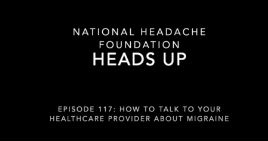


Operation Brainstorm is designed to help the people who have served this country shorten their care journey and take control of their health.


Work with your healthcare team to create a treatment plan that is personalized to fit your needs, preferences, and circumstances. On average, members of the military community have experienced 10 years of non-prescription medicine use before any US Food and Drug Administration (FDA) approved headache-specific treatment is offered. 1
Treatment Options
- Abortive treatments stop a headache when it occurs. They can be pills, injections, tablets, medical devices or nasal sprays.
- Preventive treatments are taken on a regular schedule to reduce the frequency and severity of symptoms. They range from diet and exercise to mindfulness to physical therapy.
- Combination of both.


I come from a family of veterans and am keenly interested in improving the care quality and delivery for veterans living with neurologic disease, especially headache.
VHA Road Map to Treatment
Veterans experiencing symptoms should first schedule an appointment with their local healthcare provider, as the majority of care and treatment is managed within the primary care setting. To ensure readiness for an optimal discussion with their primary care physician, veterans should build their headache diary or journal by tracking:

If additional services are needed, the doctor will make referrals to the appropriate specialists who will collaborate as a multidisciplinary headache care team to create a personalized treatment plan.
Headache Care Team Specialists
- Physiatry
- Neurology
- Pain medicine
- Brain injury medicine
- Case management
- Clinical pharmacist practitioner
- Chiropractic
- Occupational therapy
- Physical therapy
- Recreation therapy
- Psychology
- Vision therapy
- Other consultative services
To obtain additional information, the doctor will evaluate 12 features or “red flags” to make an accurate diagnosis. Partnering in a shared decision-making process helps veterans and their care team members develop treatment goals to improve outcomes, as well as identify potential triggers that lead to headaches and how to avoid them.3
To receive treatment through the VHA, veterans can be referred to one of the 28 Headache Centers of Excellence (HCoE) across the country. These centers are designed to improve headache care access for veterans living with headache disease.4 Veterans who do not live near or have access to a HCoE can also receive care at their local VA Medical Center or one of the VHA’s 800 Community Based Outpatient Clinics.
Questions to Ask the Doctor
To partner in the creation of a treatment plan that is tailored to fit their needs, preferences and circumstances, veterans should advocate for themselves by asking5:

The Promise to Address Comprehensive Toxics Act
The PACT Act ensures that veterans are eligible for expanded disability benefits for chronic headaches related to burn pit smoke and other toxic exposures. Learn more at the PACT Act website.


References
- Data from the VA Centers for Excellence, 2022.
- Migraine and Headache Care for Veterans. National Headache Foundation. Published May 1, 2024. Accessed May 1, 2024.https://headaches.org/operationbrainstorm/
- VA/DoD Clinical Practice Guideline for the Management of Headache Patient Summary. U.S. Department of Veterans Affairs and Department of Defense. Published May 1, 2024. Accessed May 1, 2024. https://www.healthquality.va.gov/guidelines/pain/headache/VA-DoD-CPG-Headache-Patient-Summary.pdf
- Smith, J. Operation Brainstorm presentation at the 2023 American Legion National Convention.
- VA/DoD Clinical Practice Guideline for the Management of Headache Patient Summary. U.S. Department of Veterans Affairs and Department of Defense. Published May 1, 2024. Accessed May 1, 2024. https://www.healthquality.va.gov/guidelines/pain/headache/VA-DoD-CPG-Headache-Patient-Summary.pdf




